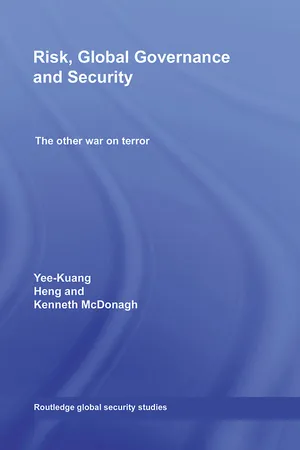Notes
1 The other war on terror
1 This is an idea also floated by Louise Amoore and Marieke de Goede, ‘Transactions after 9/11: the banal face of the preemptive strike’, Transactions of the Institute of British Geographers, Vol. 33 No. 2, January 2008, p. 182.
2 Bruce Hoffman, ‘Remember Al Qaeda? They’re baaack!’ LA Times, 20 February 2007. Online, available at: http://www.latimes.com/news/opinion/la-oe-hoffman20feb20,0,2283472.story (accessed 17 October 2008).
3 Annual Threat Assessment of the Intelligence Community for the Senate Armed Services Committee 27 February 2008, p. 4. Online, available at: http://www.dni.gov/testimonies/20080227_testimony.pdf (accessed 14 August 2008).
4 Remarks by Ted Gistaro, National Intelligence Officer for Transnational Threats, the Washington Institute for Near East Policy, Washington, DC, 12 August 2008. Online, available at: www.odni.gov/speeches/20080812_speech.pdf (accessed 14 August 2008).
5 See ‘A not very private feud over terrorism’, New York Times, 8 June 2008; and Marc Sageman and Bruce Hoffman, ‘Does Osama still call the shots?’ Foreign Affairs, Vol. 87 No. 4, July/August 2008, pp. 163–166.
6 Amoore and de Goede, ‘Transactions after 9/11: the banal face of the preemptive strike’, pp. 173–174.
7 Daniel W. Drezner, ‘The new new world order’, Foreign Affairs, March/April 2007, pp. 34–46.
8 Joseph Nye, ‘Global governance’, Washington Post, 27 January 2008, p. BW04.
9 Hearing of the House Armed Services Committee, 10 September 2008. Online, available at: www.jcs.mil/j_directors/10SEP08_CJCS_HASC_testimony.pdf (accessed 12 September 2008).
10 For a sample selection, see William Vlcek ‘Money, terror and protecting the West’, The Round Table: The Commonwealth Journal of International Affairs, Vol. 97 No. 395, April 2008, pp. 305–311; Ibrahim Warde, The Price of Fear: Al-Qaeda and the Truth Behind the Financial War on Terror, London: I.B. Tauris, 2007; Thomas J. Biersteker and Sue E. Eckert (eds), Countering the Financing of Terrorism, London and New York, Routledge, 2007.
11 Louise Amoore and Marieke de Goede, ‘Governance, risk and dataveillance in the war on terror’, Crime, Law and Social Change, Vol. 43 No. 2–3, 2005, pp. 149–173; Claudia Aradau and Rens van Munster, ‘Governing terrorism through risk: taking precautions, (un)knowing the future’, European Journal of International Relations, Vol. 13 No. 1, 2007, pp. 89–115; Gabe Mythen and Sandra Walklate, ‘Terrorism, risk and international security: the perils of asking “what if?”’ Security Dialogue, Vol. 39 No. 2–3, 2008, pp. 221–242; Amoore and de Goede, ‘Transactions after 9/11: the banal face of the preemptive strike’, pp. 173–185; Jon Coaffee, Terrorism, Risk and the City: The Making of a Contemporary Urban Landscape, Aldershot, Ashgate, 2003.
12 Daniel Byman, The Five Front War: The Better Way to Fight Global Jihad, New Jersey: Wiley, 2007.
13 David Cortwright and George Lopez (eds), Uniting Against Terror: Cooperative Non-military Responses to the Global Terrorist Threat, Cambridge, MA:MIT Press, 2007.
14 Drezner, ‘The new new world order’.
15 Drezner, ‘The new new world order’.
16 George W. Bush, ‘President freezes terrorist assets’, remarks by the president, Secretary of Treasury O’Neill and Secretary of State Powell on Executive Order on Terrorist Financing (EO 13224), The Rose Garden, 20 September 2001. Online, available at: www.whitehouse.gov/news/releases/2001/09/20010924–4.html (accessed 20 October 2006).
17 The White House, National Strategy for Combating Terrorism, ‘Overview of America’s national strategy for combating terrorism’, July 2006. Online, available at: www.whitehouse.gov/nsc/nsct/2006/sectionI.html (accessed 13 September 2008).
18 The White House, National Strategy for Combating Terrorism, Washington, DC, 2003, p. 1
19 National Strategy for Combating Terrorism, 2003, pp. 20–21.
20 See for instance Giles Andreani, ‘The war on terror: good cause, wrong concept’, Survival, Vol. 46 No. 4, December 2004, pp. 31–50; Michael Howard, ‘What’s in a name? How to fight terrorism’, Foreign Affairs, Vol. 81 No. 1, January/February 2002, pp. 8–13; Yee-Kuang Heng, ‘Unravelling the war on terrorism: a risk management exercise in “war” clothing?’ Security Dialogue, Vol. 33 No. 2, June 2002, pp. 227–242.
21 Cited in Eric Schmitt and Thom Shanker, ‘Washington recasts terror war as “struggle”’, New York Times, 27 July 2005.
22 An example would be Mel Gurtov, Superpower on Crusade: The Bush Doctrine in US Foreign Policy, London: Lynne Rienner, 2006.
23 US Department of Defense, Quadrennial Defence Review, February 2006, p. 22.
24 Jonathan Stevenson, ‘Demilitarising the “war on terror”’, Survival, Vol. 48 No. 2, Summer 2006, p. 37.
25 Stevenson,’Demilitarising the “war on terror”’, p. 48.
26 ‘Morrocco’s gentle war on terror’, TIME, 6 August 2008. Online, available at: http://www.time.com/time/magazine/article/0,9171,1829931,00.html?xid=rss-topstories (accessed 12 September 2008). The ‘Quiet war on terror’ was also explored in a five-part series broadcast by NPR in November 2005.
27 Remarks at George Washington University, 16 March 2005. Online, available at: www.dhs.gov/xnews/speeches/speech_0245.shtm (accessed 12 September 2008).
28 John Hobson and Leonard Seabrooke (eds), Everyday Politics of the World Economy, Cambridge: Cambridge University Press, 2007.
29 Marieke de Goede, ‘The politics of preemption in the war on terror’, European Journal of International Relations, Vol. 14 No. 1, 2008, p. 162.
30 New Scientist, 17 September 2005, Issue 2517.
31 John Adams, ‘The world’s biggest ideas: risk’, New Scientist, 17 September 2005, Issue 2517, p. 187.
32 HM Government, Countering International Terrorism: The United Kingdom’s Strategy, July 2006, p. 1.
33 HM Government Cabinet Office, National Risk Register, 2008, p. 3.
34 HM Government Cabinet Office, The National Security Strategy of the United Kingdom: Security in an Interdependent World, Cm7291, March 2008.
35 Ulrich Beck, ‘The world ...
